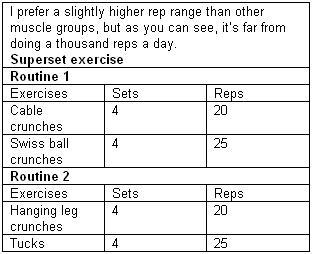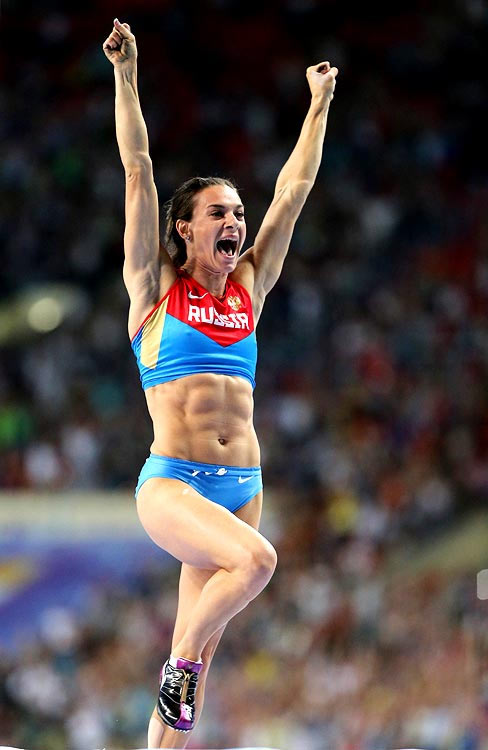 | « Back to article | Print this article |
Here's how you can get 6-pack abs!
Fitness trainer Jivesh Shetty offers simple tips to get that enviable body.
1. The abdominals are ‘stabilising’ muscles with a limited range. Unlike other movements, where we are told to maintain a neutral or normal arch for our back. While training abs we must in fact lose this arch or round our backs by rolling up our spines.
2 Every ab exercise is just a variation of the sit up or leg raise. They ‘assist’ in pulling the trunk forward and ‘assist’ in raising the legs upward.
The actual exercises that isolate the abdominals (rectus abdominus) are variants of the above two mentioned exercises i.e. forward and reverse crunches.
While performing the leg raises or sit-ups the hip flexors do most of the work and there is very little direct stimulation of the abdominals. Also most people use too much momentum further reducing the work done by the abdominals. The lower back tends to fatigue before the abs get a good workout when doing high rep sit-ups.
3. Unlike other muscles training abs can be unsatisfying sometimes. This is because they comprise mostly of tiny slow twitch, red muscle fibers, the kind that ‘burn’ so badly when stressed much like the calve muscle. They also don’t give us the same kind of pump as we get while training chest or arms muscles.
But keep in mind that the abs are the ‘showpiece’ of your body. You can be muscular beyond belief but if your abs are soft, to most people you're just a big fat guy. But someone with an average physique and killer abs can look spectacular!
4. Also, like the calves, abdominal development is mostly determined by genetics and are the least receptive to exercise. That's a bad combination for most as they are no fun to train and the slowest to grow.
Consistency here is the key then and training at least 1-2 times intensely per week is the solution.
Personally, I only do about 15 minutes of abs work two times per week, performing two exercises for about 20-25 reps per exercise.
Here’s my current abs routine that I’ve used. I do this routine only twice a week and I change the exercises approximately every few months so my body doesn’t adapt.

The author is Strength & Conditioning Coach, Birla Wellness.
Here's how you can get 6-pack abs!
5. The abdominals are stressed most severely when attempting to ‘stabilise’ since that's their function. This means that they respond to contraction, not just movement. Training important compound movements such as dead lifts, squats, push presses, pull ups, uprights rows works heavily on the mid section. Guys focusing on these heavy compound movements and not just doing various forms of crunches have a thick and muscular midsection.
6. Ab work should not be an ‘afterthought.’ Hit them hard as you would legs or chest. After a couple of weeks, you may start seeing definition in your abdominal region you never thought possible. Once you've achieved more muscularity and less fat, it will be easier to maintain. You'll feel better and improve your overall look.
7. Use very strict form in your abdominal training, and that includes performing the exercises slowly and deliberately with physical and mental concentration on the quality of contraction. A lot of people are conditioned to do abs exercises such as sit-ups for time, but fast reps reduce the quality of muscle contraction because the movements are being executed with momentum and not muscle action. This can also increase the likelihood of injury. Slow down and squeeze!
8. Remember to exhale forcefully as you crunch because this forces your abs to work harder.
9. Abdominal crunches involve spinal flexion, and if you do hundreds of crunches a day and you neglect extensions and the lower back, there is a likelihood of injuries due to overuse or muscle imbalance. Work on as much spinal extension as spinal flexion. Dead lifts and Lower back extensions, use spinal extension.
10. There’s no single number or chart that will apply to everyone because the physical appearance of different people have at the same body fat level can vary a lot. One woman can look totally ripped with six-pack abs at 16 per cent body fat and another can look as if she’s still holding a little visible fat in the abs at the same 16 per cent. This is just genetic uniqueness in how and where we store our fat.
Body fat measurements should be used as a way to track your progress from one week or one month to the next, not to compare yourself to someone else or to a certain standard on paper.
Men
- Very Lean (excellent): 9 per cent or less
- Lean (good): 10 to 14 per cent
- Average (fair): 15 to 19 per cent
- Below average (poor): 20 o 25 per cent
- Serious improvement needed: 26 to 30+ per cent
Women
- Very Lean (excellent): 15 per cent or less
- Lean (good): 16 to 20 per cent
- Average (fair): 21 to 25 per cent
- Below average (poor): 26 to 30 per cent
- Serious improvement needed: 31 to 35+ per cent
As a general guideline, most men will start to see some abdominal definition when they drop under 15 per cent body fat into the single digits. Women usually start to show abdominal definition when their body fat drops under 20 per cent.
Single-digit body fat is rare for women except for physique athletes and endurance athletes, and it’s not realistic to expect to stay that lean and probably not healthy either. The more well developed the abdominals are the more visible they will be at a higher body fat.
Here's how you can get 6-pack abs!
11. It takes training to increase strength, build the abdominals, but to see the definition in your abdominals is almost entirely the result of low body fat levels. It’s a huge mistake to think that hundreds or thousands of reps of abs exercises will remove lower abdominal fat, except to the degree that it burns calories and contributes to a calorie deficit. What removes the fat -- all over your body -- is a calorie deficit and that comes from decreasing food intake, increasing activity, or a combination of both.
12. Nutritional guidelines: Abdominals are made in the kitchen, not in the gym is a very common phrase amongst the gym trainees. But in essence it is absolutely true. You can do thousands of reps of abs work every week, but if your nutrition is not in order, you can forget about getting a great set of 6-pack abs.
Here are some nutrition secrets for great abs:
1. Cut your calorie intake by about 20 per cent below your calorie maintenance level. But do not keep calories too low for too long.
2. 1 to 2 days per week go back to your maintenance calorie level. This will help re-stimulate your metabolism. This kind of calorie cycling is essential for long sustaining results.
3. Spread your calories into 5-6 smaller meals instead of 2 to 3 big ones. Be very conscious of portion size. If you eat too much of anything (even ‘healthy’ food), you can say goodbye to your abs.
4. Eat a source of complete, high quality lean protein with each meal (egg whites, lean meat, fish, protein powder, etc.)
5. Choose natural, complex carbs such as vegetables, oatmeal, yams, potatoes, beans, brown rice and whole grains. Start with approximately 50 per cent of your calories from natural carbs and reduce carbs slightly if you are not losing fat.
6. Avoid refined, simple carbs that contain white flour or white sugar.
7. Keep total fats low and saturated fats low. Aim for 20 per cent of your total calories from fat (and no more than 30 per cent). A little bit of ‘good fat’ like flaxseed oil, fish fat, nuts and seeds, and so on, is better than a no-fat diet. Essential fatty acids actually assist the fat burning process.
8. Avoid high sodium foods. A high sodium diet will increase your water retention leaving you looking bloated and fatter than you really are. Controlling your sodium intake will also help your body to operate more efficiently and burn fat easier by maintaining proper hydration. It will be easier for you to avoid high sodium foods by just avoiding processed foods such as canned foods or prepared foods. Almost all processed foods are heavily laden with salt, in addition to trans fats and high fructose corn syrup many times as well.
9. Limit alcohol consumption: The occasional night out of drinking isn’t going to kill your efforts to get lean, but getting wrecked almost every night will definitely bring on the abdominal fat. And for someone on a serious 6-pack programme alcohol is a clear ‘NO’.
10. Drink plenty of water: 1000 or more reps of daily abs work is great for abdominal endurance, but like most other muscles they need to be trained in short intense sessions. That is the only way to build any muscle. But even with many years of training they may never be seen, if your abs are covered up with a layer of fat.


